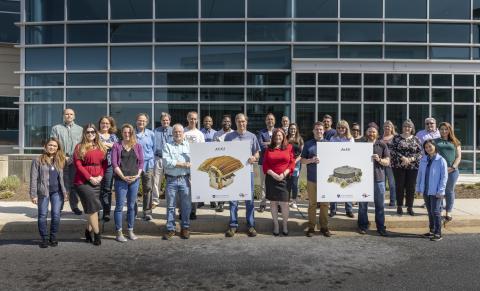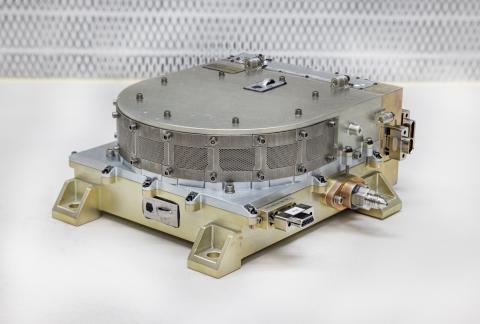
After a decade in the making, the Particle Environment Package (PEP)-Hi instruments, built by the Johns Hopkins Applied Physics Laboratory (APL) in Laurel, Maryland, for an upcoming mission to Jupiter, are finished and prepped for spacecraft installation.
PEP-Hi, comprising two particle detection instruments — Jupiter Energetic Neutrals and Ions (JENI) and Jovian Energetic Electrons (JoEE) — is scheduled to ship in June to Airbus Defense in Toulouse, France, where later this summer it will be installed on the European Space Agency’s JUpiter Icy moons Explorer (JUICE) spacecraft. The two innovative instruments are part of the larger PEP suite of six instruments, led by Stas Barabash at the Swedish Institute of Space Physics in Kiruna.
Slated to launch in September 2022, JUICE will study Jupiter and three of its largest moons, Ganymede, Callisto and Europa, each of which scientists believe hosts a liquid water ocean beneath icy surfaces. JoEE and JENI, which are part of NASA’s contribution to the mission, will play a significant role in uncovering never-before-seen details about the Jovian system, especially the radiation environment around it and the planet’s interactions with its moons.
“These are unprecedented instruments,” said APL’s Cori Battista, the PEP-Hi program manager. “I am excited to see what they send back because they will be contributing groundbreaking science.”
SEEING UNIMAGINABLE THINGS
Bedecked in gold plating and flared out like a hand fan, JENI will act as both an ion spectrometer and energetic neutral atom (ENA) imager, a type of camera that captures images using atoms instead of light. That difference allows it to photograph invisible space phenomena, such as a planet’s magnetosphere and, of particular interest, the trail of gas from Jupiter’s icy moon Europa.

Although researchers believe particles bombarding Europa’s surface and perhaps even recently detected water plumes are responsible for the enormous gas cloud behind Europa as it orbits Jupiter, its origin and appearance have remained a mystery. JENI will finally capture up-close, detailed views of this gas cloud as well as explore how the vast regions of plasma in Jupiter’s magnetosphere are heated to temperatures exceeding those of the Sun’s corona — close to 2 million F (more than 1 million C).
“I am convinced we are in for a lot of surprises and will see things we never imagined,” said APL’s Pontus Brandt, a space physicist and PEP-Hi’s principal investigator. “The Jovian system is like a miniature solar system, hosting all kinds of secrets that are just waiting for us.”
JoEE, on the other hand, is a multidirectional spectrometer designed to obtain electron spectra almost simultaneously from nine directions. Resembling a large, metallic hockey puck, JoEE will study the magnetosphere around Ganymede and take measurements that will help scientists understand what makes Jupiter the strongest particle accelerator and the fiercest radiation environment in the solar system.
“Once in orbit around Ganymede, JoEE will explore the exotic space interactions that occur as this large, magnetized moon plows through Jupiter’s magnetic field, and it will even help shed light on Ganymede’s interior ocean,” Brandt explained.
For the team leads, finally seeing these instruments completed and shipped for installation will yield a mixed bag of emotions; they have traversed obstacle after obstacle to get PEP-Hi built and ready, and each barrier required creative solutions and dogged tenacity to overcome.
“It is such a relief to finally reach this point. The PEP-Hi team overcame many hurdles to get here, not the least of which was a worldwide pandemic,” Battista said.

DODGING ROPES AND BUMPS
The challenges started with JENI. When Brandt proposed the idea of an ENA imager for JUICE back in 2009, many of his colleagues were skeptical.
“The people at ESA didn’t know what the science of an ENA imager would be, what it would do,” Brandt explained. They weren’t certain of an ENA imager’s value, in general, but especially around Jupiter.
“Jupiter is the harshest radiation place in the solar system,” Brandt reemphasized, “so flying a camera and taking pictures there is really tough.” Every second, an ENA camera could have up to 1 million electrons and photons strike its sensor, resulting in images that look more like the noisy static on a TV than a clean, pristine picture.
Getting clean data requires coincidence systems — clever ways of isolating sensor signals. In JENI’s case, it meant isolating the particles of interest, which will strike a piece of foil in the instrument and knock off electrons with enough energy that they will take just 3 nanoseconds — 3 billionths of a second — to reach the sensor. Anything shorter or longer will be from an unwanted particle and can be thrown away.
“You completely clean out all of the background, reducing the noise dramatically,” Brandt said.
After a joint NASA and ESA competition, and a good chunk of a nearly 1,000-page proposal, the team ultimately got buy-in for the JENI instrument.
JoEE’s development, on the other hand, required a design element that pushed the limits of additive manufacturing — or 3D printing — for space applications.
Stretched across JoEE’s front are nine quarter-sized stainless steel plates, punctured with 518 tiny holes that are each only a hair’s width apart. They make up JoEE’s collimator, which is curved to match a magnetic field that aligns electrons coming into the instrument. And that curve turned out to be a problem.

“It’s a really elegant solution, but the design was an evolution of how they made traditional collimators, and it just couldn’t be manufactured,” said Michael Presley, an additive manufacturing engineer at APL. Instead, the team considered 3D printing the pieces, an approach that APL had never taken before, to more effectively (and accurately) build the parts. In only three days, Presley showed it could work.
The manufacturing process required hours with NASA Marshall Space Flight Center personnel, the only branch of NASA at the time with a standard process in place for 3D printing space parts, to set up specific protocols and machining processes to ensure JoEE’s parts were developed correctly and qualified for spaceflight. After final approval, it set a new standard for APL to use additive manufacturing for space instruments.
Getting buy-in and surmounting design issues were just the beginning. Battista said that since 2013, when the instruments were selected for the JUICE mission, the PEP-Hi team has fought through many more hurdles: motors malfunctioning, key engineers leaving for new positions, instrument issues and, of course, the COVID-19 pandemic.
“In the past year alone, we had three to four major issues that we had to overcome,” she said, all while operating with fewer than 10 people on APL’s campus and adhering to strict social distancing and masking protocols.
The PEP-Hi team will have to wait until the summer, if the pandemic abates, to travel to Europe to help integrate and test JoEE and JENI with the JUICE spacecraft. That has everyone slightly on edge, Battista said. But after years of tireless fighting, there is still a sense of relief.
“I definitely cried,” Battista said, when the instruments received NASA’s and ESA’s approval to ship — the last major milestone before delivery. That, in part, was because she will be sad to see the instruments go, like saying goodbye to your kids as they head off to college. But the tears were also in part from joy, because she will finally be able to get some sleep.
Banner Image: Artist's concept of Ganymede and its auroras. Credit: NASA
Related Topics
For Media Inquiries
For all media inquiries, including permission to use images or video in our gallery, please contact:
Michael Buckley
All Media Resources

